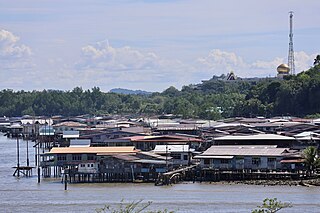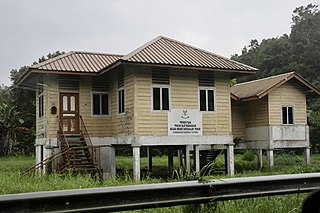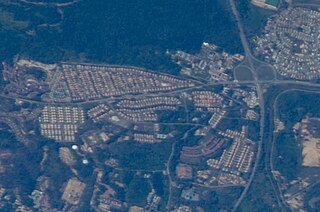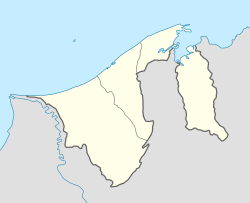
Mukim Kilanas is a mukim in Brunei-Muara District, Brunei. The population was 22,492 in 2016.

Mukim Sungai Kebun is a mukim in Brunei–Muara district, Brunei. It is part of Kampong Ayer, the traditional stilt settlements on the Brunei River in the capital Bandar Seri Begawan. The population was 4,750 in 2016.

Mukim Sungai Kedayan was a mukim in Brunei-Muara District, Brunei. It was located within Kampong Ayer, the historical stilt settlements on the Brunei River in the capital Bandar Seri Begawan. The population was 230 in 2016.

Mukim Tamoi is a mukim in Brunei-Muara District, Brunei. It is part of Kampong Ayer, the traditional stilt settlements on the Brunei River in the country's capital Bandar Seri Begawan. The population was 1,389 in 2016.

Kampong Beribi or commonly known as Beribi, is a village in Brunei-Muara District, Brunei, as well as a neighbourhood in the capital Bandar Seri Begawan. The population was 5,679 in 2016. It is one of the villages within Mukim Gadong 'B'. The postcode is BE1118.

Kampong Tungku is a village in Brunei-Muara District, Brunei, about 10 kilometres (6.2 mi) from the capital Bandar Seri Begawan. The population was 1,689 in 2016. It is one of the villages within Mukim Gadong 'A'. The postcode is BE2119.

STKRJ Tungku Area 1 is a public housing estate and village within Mukim Gadong 'A' in Brunei-Muara District, Brunei. The population was 1,332 in 2016. The postcode is BE2519. It is one of the estates for the Landless Indigenous Citizens' Housing Scheme, the public housing programme for the country's indigenous citizens.
STKRJ Tungku Area 2 is a public housing estate and village within Mukim Gadong 'A' in Brunei-Muara District, Brunei. The population was 1,862 in 2016. The postcode is BE2519. It is one of the estates for the Landless Indigenous Citizens' Housing Scheme, the public housing programme for the country's indigenous citizens.

Kampong Katok is a village in Brunei-Muara District, Brunei, about 8 kilometres (5.0 mi) from the capital Bandar Seri Begawan. The population was 2,079 in 2016. It is one of the villages within Mukim Gadong 'A'. The postcode is BE2319.

Kampong Kiulap or commonly known as Kiulap, is a village in Brunei–Muara District, Brunei, as well as a neighbourhood and commercial area in the capital Bandar Seri Begawan. It has an area of 176.53 hectares ; the population was 3,400 in 2016. It is one of the villages within Mukim Gadong 'B'. The postcode is BE1518.

Kampong Madang is a village in Brunei-Muara District, Brunei, as well as a neighbourhood in the capital Bandar Seri Begawan. The population was 1,231 in 2016. It is one of the villages within Mukim Berakas 'B'. The postcode is BC3715.

Kampong Sungai Kelugos is a village in Tutong District, Brunei, about 14–15 kilometres (8.7–9.3 mi) from the district town Pekan Tutong. The population was 900 in 2016. It is one of the villages within Mukim Keriam.

STKRJ Katok 'B' or Kampong Katok 'B', also known as STKRJ Mata-Mata, is a public housing estate in Brunei-Muara District, Brunei, about 11 kilometres (6.8 mi) from the country's capital Bandar Seri Begawan. The total population was 6,108 in 2016. It is one of the estates for the Landless Indigenous Citizens' Housing Scheme, a public housing programme for the country's indigenous citizens.
Kampong Perpindahan Mata-Mata or simply known as Perpindahan Mata-Mata, is a public housing estate and designated village in Brunei-Muara District, Brunei, on the outskirts of the capital Bandar Seri Begawan. The population was 2,385 in 2016. It is one of the villages within Mukim Gadong 'B'. The postcode is BE1918.

Kampong Manggis is a village in Brunei-Muara District, Brunei, as well as a neighbourhood in the capital Bandar Seri Begawan. The population was 4,229 in 2016. It is one of the villages within Mukim Berakas 'B'. The postcode is BC3615.

Kampong Menglait or simply known as Menglait, is a village in Brunei–Muara District, Brunei, as well as a neighbourhood and commercial area in the capital Bandar Seri Begawan. The population was 2,262 in 2016. It is one of the villages within Mukim Gadong 'B'. The postcode is BE3919.

Tungkadeh, commonly known as Mabohai, is a small neighbourhood in Bandar Seri Begawan, the capital of Brunei. It is officially a village subdivision under Kianggeh, a mukim (subdistrict) of Brunei-Muara District. The postcodes for Tungkadeh are BA1111 and BA1311.

RPN Kampong Rimba or Kampong Rimba National Housing Scheme is a public housing area in Brunei-Muara District, Brunei, on the northern outskirts of the capital Bandar Seri Begawan. The total population was 15,658 in 2016. It is part of Mukim Gadong 'A', a mukim in Brunei-Muara District.

Kampong Sungai Hanching is a village in Brunei-Muara District, Brunei. The population was 2,987 in 2016. It is one of the villages within Mukim Berakas 'B'. The postcode is BC2115.

Skim Tanah Kurnia Rakyat Jati (STKRJ) Kampong Rimba or STKRJ Rimba is a public housing area on the northern outskirts of Bandar Seri Begawan, the capital of Brunei. It is officially a village subdivision under Mukim Gadong 'A', a mukim in Brunei-Muara District. It has an area of 69.15 hectares ; the population was 5,023 in 2016.




















